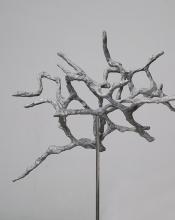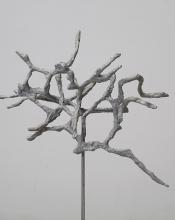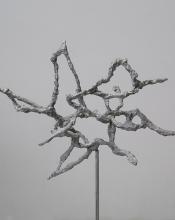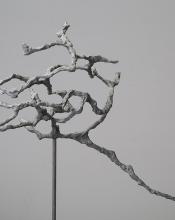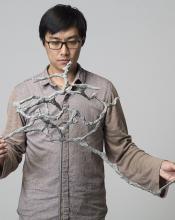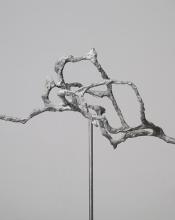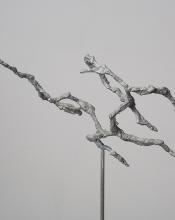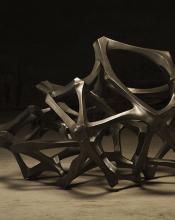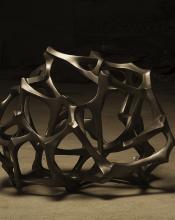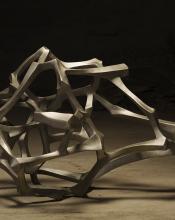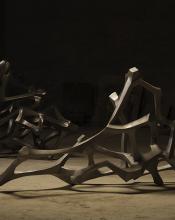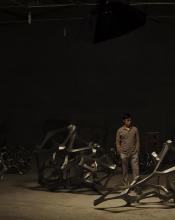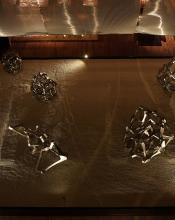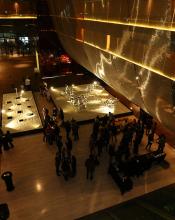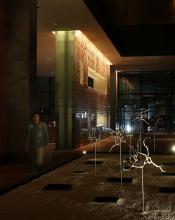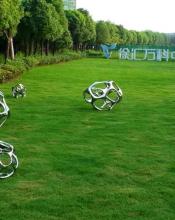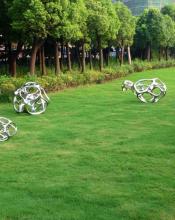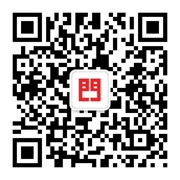Pan Kai
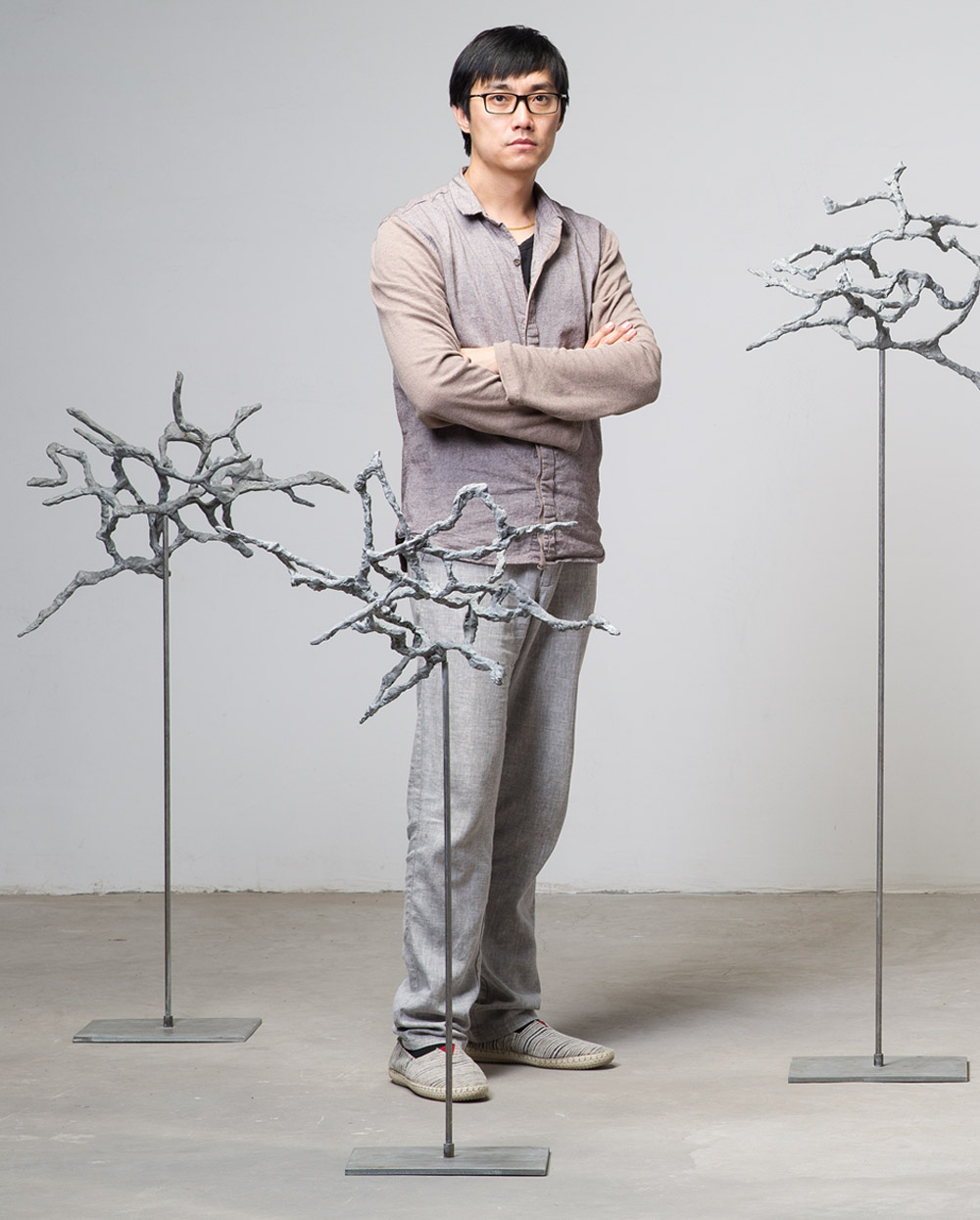
“We welcome you to visit our hotel Atrium to view Kai Pan’s work of art. Through these art pieces Kai Pan has subtlety projected that art is not only a means of engaging feelings and expressions, it also provides an aesthetic experience. ”
Peter Wynne (Area General Manager of Swire Hotels)
October 10, 2014
at The Opposite House, Beijing
Material Objects from the Sculptor’s Hands:
Contemplating Pan Kai’s Objects from the Void
Zhao Guochen
Objects from the Void comprises two major composite works, Understatement and Self-Organization, that bring together abstract, sculptural pieces fashioned from stainless steel.
Each of the seven smaller sculptural pieces that constitute Understatement confronts the viewer on its own fine columnar stand. Each piece is devoid of figural or imagistic referents, yet the pieces simply project their linear irregularity throughout the entirety of the exhibition space. Pan Kai brought his unique creative style to this work, with each component fashioned by hand within the confines of two to three hours, thereby optimally guaranteeing direct interaction between the artist and the materials being sculpted, and obviating the need for revision and mental regrouping whenever the direct perception and full intensity of the creative act might dissipate. Pan Kai’s technique of creatively working with only his bare hands is embodied in the preservation within the work itself of the artist’s finger prints and the other manual traces of the creative act. The rapidity of the sculpting necessitated by the temporal restrictions Pan Kai placed on his work finds its embodiment in the intuitive ramifications of the lines of the total work. Pan Kai’s creative mode ensures the purest expression of the special qualities of the medium of sculpture. The perfection of each individual sculptural element exemplifies the artist’s meditation on the nature of his materials at its most intuitive. The indeterminacy conjured up by the abstract lines and the purity of the sculptural materials manifest the supreme charm of this composite work.
Five larger network clusters constitute the second group of Pan Kai’s works collectively titled Self-Organization. This series was initiated in 2012, and to date the artist has completed five pieces in this ongoing series. Self-Organization extends the style of the artist’s abstractionism, boldly transforming the images and forms of Chinese calligraphy into the standing, spatial forms of sculpture and bringing dynamism to the planar conceptions that inform Chinese calligraphy. The hesitations and twists in the flow of the calligrapher’s brush fully imbue these sculptural realizations of calligraphic form and extraordinary imaginative feats endow each “brush stroke” with multi-dimensionality. The three smaller pieces in this group form a cluster that opens up into the two larger pieces. The vigorous and forceful “momentum of the brush” is captured in space for us to contemplate in wonder. The entire work presents an inter-play of ease and tension, as though pressure is alternately applied and then released. Moreover, the qualities of abstraction draw on the textural feel of the stainless steel, so that the work in its totality acquires additional meanings and readings: the skeletal structures of buildings at ruined sites, the internal organization of biological organisms, the structuring of minerals, or even the tracery left by the movement of light.
1978 Born in Dalian
2002 Graduated from the Nanjing Art Institute with Bachelor's degree
2005 Graduated from the Central Academy of Fine Arts in Beijing with Master’s Degree
Present: Lives and works in Beijing
Solo Exhibitions
|
2014 |
Objects from the Void, Sculptural Works, The Opposite House, Beijing |
|
2011 |
±0, Levant Art Gallery, Shanghai |
Group Exhibitions
|
2019 |
Czech Day - A Cultural Tour of the Czech Republic, Embassy of the Czech Republic in Beijing |
|
|
Cabinet of Curiosities III, Duoyuanxuan Art Center, Shanghai |
|
|
1000 Kilometers, Bao Space, Weihai |
|
|
Art Collection of China Czech Contemporary Art Museum, Czech China Contemporary, Beijing |
|
|
Nihil · Natura · Melius - Jiangsu Art Foundation, Nanjing, Florence, Athens |
|
2018 |
WO ART CHAO, Sanlitun CHAO, Beijing |
|
|
Travelling in Art, Hui Art Space, Beijing |
|
|
Boundary of Object - 4th Sculpture Studio CAFA, CAFS Art Tao Xichuan Art Museum, Jingdezhen |
|
2017 |
Red Gate on the Move, Red Gate Gallery |
|
|
1st International Sculpture Exhibition, Jinhai Lake |
|
|
Young Sculptors in National Art Colleges and Universities, Nanjing University of Arts, Nanjing |
|
2016 |
Boundless Creativity and Art - Shanghai Jiao Tong University of Sculpture Art Shanghai 2016 |
|
|
Wuhan Sculpture of Young Artist in Big House, Wuhan |
|
2015 |
Contrasts - New Potential Design Arts, Beijing |
|
|
Market near Heaven, Czech Chinese Contemporary, Beijing |
|
|
Independent Venice Biennale, Venice |
|
2014 |
Scatter Explore in the Broken Age, Beijing Lotus Art Museum |
|
2013 |
Materialism - Guo Zilong, Li Jinguo, Pan Kai and Song Jianshu, Red Gate Gallery |
|
|
Future Master, Winshare Art Museum, Chengdu |
|
2012 |
CAFA Sculpture Retrospective, Beijing |
|
|
100% Design Shanghai, Shanghai Exhibition Center |
|
2011 |
Contemporary Sculpture, Tianjin |
|
|
Black and White Songzhuang - Songzhuang Documentary, Urumqi |
|
2009 |
Here·We Contemporary Sculpture, Levant Art Gallery, Shanghai |
|
|
Angle 12 - Contemporary Young Sculptors, Beijing |
|
|
Enliven - In Between Realities and Fiction - Animamix Biennial, Today Art Museum, Beijing |
|
2008 |
1st Annual Moon River Sculpture Festival, Moon River Museum of Contemporary Art, Beijing |
|
|
100 Tales in Animamix, Linda Gallery, Beijing, Jakarta and Singapore |
|
2007 |
New Elements: Contemporary Sculpture, Dafeng Gallery, Beijing |
|
|
345° Shanghai Fresh Art, Shanghai Duolun Museum of Modern Art, Shanghai |
|
|
Beijing BS1 Contemporary Museum 2007 Nomination, Shanghai Zhu Qizhan Art Museum, Shanghai |
|
2006 |
2006 Spring Invitational, Shanghai Sculpture Space, Shanghai |
|
2005 |
54th International Ceramic Art Exhibition, Faenza, Italy |
Artist’s Statement :
Over the past few years, tradition and nature have been the constant source for everything I do; although these two systems are independent of each other they are nevertheless interconnected, together forming a more powerful source of energy, leading me to think about my associations with both, about what I can do, and how I should go about doing it.
Later I began to think about the source and discovered the independent value of the line, the line being the most original, as well as the most essential, aspect of visual art. Mankind’s earliest drawing and writing began with the line. At the same time, in Chinese traditional painting, lines have been refined over millennia, but in their properties they have never distanced themselves from the depiction of specific images, and this is the destiny of the line in traditional Chinese painting; it is also for this reason that I hope to use the space provided by sculpture to conduct an experiment that will test the independent aesthetic value of the Chinese traditional line itself and its new spatial possibilities. I hope that through such an experiment I will discover and understand the unusual fluctuations and energy that might arise from the abstract combination of lines.
At the same time, I want artistic language to not only be a mode of expression but to be even more an internalized aesthetic experience and cultural position. Based on such an understanding, I want to construct a personal system within which the ontology of artistic language will become an object of expression and, through the logical associations and controls of this ontology of language, I will attain the original meaning of the work itself—my individual understanding and imagining of the world.
It is worth mentioning here that, because the final shape of my work will not settle as a specifically identifiable image, this will make it look not only unreal but also difficult to understand. However there are times when we discover that the things we can visualize might not necessarily be real but that some reality may be concealed within their appearance. This invisible reality is what I call the concealed "objects of the void"; it hints at the void within Chinese culture and the rich variety of things we perceive that have evolved from this void. Just as our lives and the entire universe have come from the void, so they will return to the void. This constant cycle of transmigration fixes on something, and the void without beginning or end is the basis and axis of our world, running through all time and space and defining all we call eternal.
16th September, 2014
Sculptural Works by Pan Kai: Objects from the Void
Artist’s Introduction
Thought Experiment, 2010-2011, Stainless steel, Five pieces, Variable dimensions
My original intention in creating Thought Experiment was an attempt to construct a spatial field using pure line as a linguistic ontology in terms of artistic language, and to allow the spatial structure within this system to suggest the formation of microscopic cells as well as the universe. Cells and the cosmos share in the spirit of life, which you can think of either as the vastness of the universe or as living cells; you can also regard it as encompassing everything to do with nature, life, and reincarnation.
Self-organization, 2012-the present, Stainless steel, Five pieces, Variable dimensions
Considered from another perspective, this group of works born in 2010 can be regarded as a plan that I set for myself, which was to begin to play with lines through these works, in the hope of further excavating, from a personal perspective, lines that exist between sculpture and space and lines that themselves have independent aesthetic value.
The creation of this group of works titled Self-organization began in 2012, and my plan for these works continues to unfold. The line continues to provide the linguistic ontology and the basis for these works.
From the spatial forms, it can be said, greater conflict and uncertainty are generated. While the deployment of the lines brushes up against the use of line in traditional Chinese painting and the emphasized gesture of the line in calligraphy, we are at first still unable to distinguish between the lines and they seem to come from outer space. My intention is to create a more unknown and unfamiliar object, an object closer to the void. Visually, I want to detach [lines] from specific images; this might for a time seem to leave people groping to make sense of the work or, to put it another way, it might demand of everyone that they empty their minds for a while. Through these works I want to construct a scene free from preconceptions so that everyone can defenselessly go with the works and enter a more real, yet different, experience of the self; in this process I want to allow the scene to hint at how the “void” in Chinese traditional culture plays such an important role in cultural revelation. After the overall look of the works returns to the "void", I attempt to allow these Chinese-style lines to return to life in another dimension, so that they acquire new life. These lines only exist for themselves, and are not ancillary to specific images; they interconnect, give rise to and negate each other, without beginning and without end; they self-organize within their own space, replicating endlessly and recounting the truth concealed within all things.
Understatement, 2014, Stainless steel, Five pieces, Variable dimensions
This group of works, titled Understatement, also took shape around the concept of the “void”. Initiated this year, the group is different in that I want to introduce the line drawing of traditional Chinese painting and calligraphy more directly into the works, so that the form of these works tends more towards the intangible.
In the process of implementing these works, after the skeletal framework is fixed in space, I gave myself only two or three hours to complete each work, so that I did not create an excess of lines and was able to retain the dynamism of the material in the life of the lines. In this way, I noticed that the questions I confronted were simplified, and the much more tedious work of flattening, grinding, and polishing the objects could also be omitted from the works produced, so that visually they also became simpler and more relaxed. I think everyone can appreciate these works as being in the spirit of graffiti.



